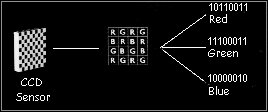Please, click the various parts of the image

Plan of the process of digitalization
Sensor
CCD
In a digital
camera it's the sensor CCD who collects the information concerning the
image (those this are passed on by the light passing in transit by the
objective).
It's
this sensor (which is big as the nail of the little finger) which takes
care to transform these light signals into digital signals.
A
sensor is constituted by sensitive cells called photodiodes which contain
themselves pixels (thus not to confuse photodiodes and pixels, as we shall
it afterward).
The more there's of photodiodes and the more you're entitled to wait for
photos of better quality. But it is not the main argument : the quality
of the objective is also essential.
Précisions and ideas



Photodiodes
are quite various (indeed, if they were the quite same, they'd react to
the light in a positive or negative way, of or a state 1 or 0, that is
black or white).
There're thus photodiodes with red, green and blue filters, each of these
colours being digitalised on 256 levels of luminosity or luminance:
What thus wants to say 256 levels of green, 256 of the red and 256 of
the blue, all these combinations of colours put together give us:
256 x 256 x 256 = 16.7 million possible colours.
![]() The
surface of a sensor contains generally more photodiodes green than blue
and red, this's in fact to adapt itself the most possible for the human
eye which is more sensitive to the green than to two other colours.
The
surface of a sensor contains generally more photodiodes green than blue
and red, this's in fact to adapt itself the most possible for the human
eye which is more sensitive to the green than to two other colours.
A sensor can restore up to 16.7 million colours, but do you know that
the human eye discerns it only on 2500, the compression of the images
is based on this peculiarity.
Internal
Software and A/N processor.
The CCD cannot
regrettably treat alone the quantity of information relative to the image
to him alone, one thus has appeal to a software of treatment (don't confuse
with the software of retouch) to calculate the data to constitute a digital
picture.
This software is internal in the device.
It's thus
the work of the CCD and the software of treatment that "make"
a digital picture.
This peculiarity is one of the inconveniences of the digital photo.
Who says said treatment time: indeed the handled data are put in a memory
"plug" which stores what is already made by waiting to receive
the continuation, the more the memory "plug" of the device is
important and the more the treatment is accelerated.
But
there's another important factor, the speed of the internal software which
is variable according to the builder.
This fact makes that the digital device works very slow as regards the
mode photo in squall.
According to the resolution and the device, one can have times of treatment
going 5 seconds.
Builders try to minimize this trouble by increasing the buffer.
Storage
The image so reconstituted is sent to the internal
memory in the device (on certain devices entry of range), on a card memory
(so called flash memory), on floppy disk or even on mini hard disk.
Sony suggests, as for him, storing photos directly in a CD-Rom
